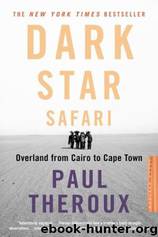Dark Star Safari by Paul Theroux

Author:Paul Theroux [Theroux, Paul]
Language: eng
Format: epub
Publisher: Houghton Mifflin Harcourt
Published: 0101-01-01T00:00:00+00:00
13
The Kilimanjaro Express to Mbeya
THE TAZARA RAILWAY, a gift from the Chinese, had been inspired by the Great Proletarian Cultural Revolution. Its construction by Chinese workers—engineers, grunt laborers, and Red Guards—had occupied the whole of China’s disastrous decade, 1966 to 1976. The Chinese intention, a worthy one, was to liberate both Tanzania and Zambia from their dependence on “imperialist,” white-dominated South Africa as a supply line. The building of the railway was also intended to demonstrate what willing hands could accomplish when hardworking peasants became rustless screws in the revolutionary machine (as the Maoist saying went). Unfortunately, there were no revolutionary peasants, only pissed-off peanut farmers getting shortchanged in the Tanzanian heartland, but the Red Guards seemed not to have noticed that. The railway was completed ahead of schedule and was, by any reckoning, a magnificent Chinese achievement.
As a way of showing their thanks to China, Tanzanian bureaucrats parroted Maoist slogans for years afterward, called each other “comrade,” and affected Mao suits. In the mid-eighties the Chinese pronounced the Cultural Revolution a horrible mistake. This revision did not reach Dar es Salaam. Long after the Chinese ceased to regard Mao as the Great Helmsman, and saw his platitudes as embarrassing, and adopted neckties and sunglasses along with the new line “To get rich is glorious,” Africans were chanting “Serve the people,” though it was the last thing anyone in Tanzania wanted to do. They were still pissed-off peanut farmers.
The Tazara Railway went into decline the moment it was finished, though over the years there were spells—convulsions, really—during which attempts were made to repair it. Some years it was unridable. Foreigners were banned from it for a while. At least now it was running, and it had been renamed the Kilimanjaro Express, though it had no connection with the mountain. “It’s always late,” I was warned in Dar. As if I cared.
The main station itself was an indicator of how little trouble anyone took to maintain the Tazara Railway. The Dar es Salaam terminus was the sort of building in which I had spent a great deal of time buying tickets and eating noodles while riding various Iron Roosters through China. Large, stark, like a Marxist mausoleum, no waiting rooms, no annexes, it was entirely open, Chinese style, designed to make it easy for police to manage crowds and keep everyone visible. “Nowhere to hide” was the subtext of Chinese urban planning. This station was from a standard Chinese blueprint, and would have suited the center of Datong—an identical station could be found in most Chinese cities. Though it seemed out of place here, it was no odder than the colonial structures: the old German office buildings or the British clubs in the center of Dar, or the Arabesque architecture of Zanzibar.
Assuming there would be delays, breakdowns, and shortages, I brought a box of food and enough bottles of water to last four days. The two-day trip to Mbeya usually took three. At Mbeya I intended to go by bus to Malawi.
Download
This site does not store any files on its server. We only index and link to content provided by other sites. Please contact the content providers to delete copyright contents if any and email us, we'll remove relevant links or contents immediately.
1610396766 (N) by Jo Ann Jenkins(1301)
Whatever You Do, Don't Run by Peter Allison(1250)
Botswana--Culture Smart! by Michael Main(1242)
In Arabian Nights by Tahir Shah(1207)
The Old Farmer's Almanac 2020 by Old Farmer’s Almanac(1159)
Livingstone by Tim Jeal(1157)
Ubuntu by Ellis Heather;(1139)
The Templars by Michael Haag(1128)
Dead Eye by Mark Greaney(1114)
Africa: Altered States, Ordinary Miracles by Richard Dowden(1083)
Top 10 Israel and Petra by DK Travel(1076)
Morocco Travel Guide by Lonely Planet(1071)
Egypt Travel Guide by Lonely Planet(1060)
The Promise of a Pencil: How an Ordinary Person Can Create Extraordinary Change by Braun Adam(1057)
False Papers by André Aciman(1055)
First Comes Love, then Comes Malaria by Eve Brown-Waite(1046)
Jeff Corwin by Jeff Corwin(1034)
The Masked Rider by Neil Peart(992)
African Nights by Kuki Gallmann(970)
